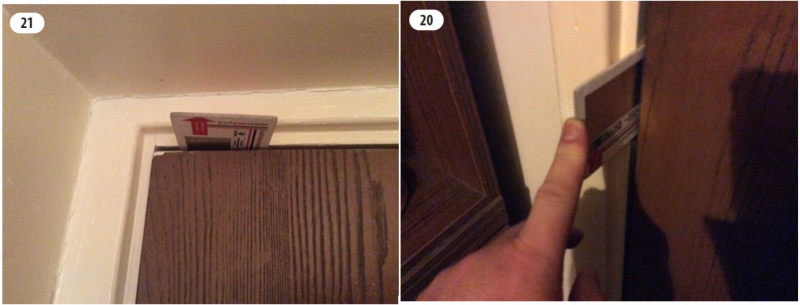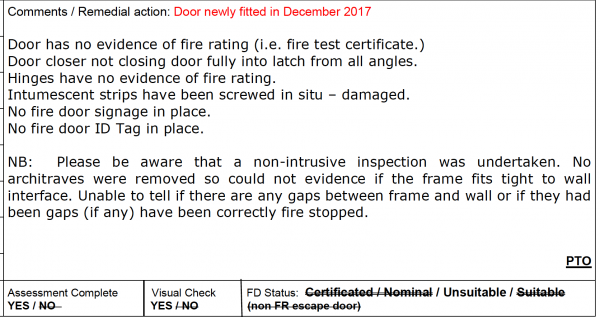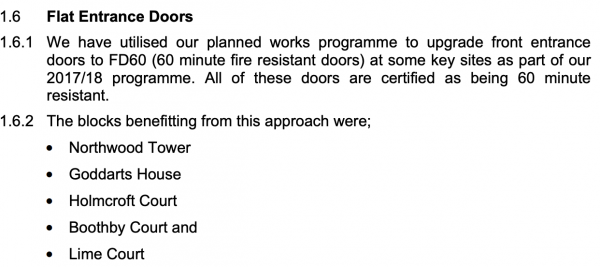Fireproofing flat entrance doors at Goddarts sheltered housing in Walthamstow: another LBWF fiasco, which has left vulnerable residents in danger, and will cost a great deal of public money to rectify
This post looks at what LBWF has done – in fact more accurately, has not done – over the past few years to make sure that flat entrance doors (FEDs) at Goddarts House sheltered housing in Walthamstow are fireproof.
It’s a story of official bungling, which endangered life and limb, and probably will cost the public purse hundreds of thousands of pounds, but also – more positively – of one determined resident’s struggles to put things right.
First some background.
When serious fire occurs, FEDs are a matter of life and death. A suitably robust FED, properly fitted, and regularly inspected, will provide vital protection, retarding flame and blocking smoke circulation, especially critical where a ‘stay put’ policy is in place (as at most LBWF blocks, including Goddarts). Conversely, a shoddy FED, badly fitted, and rarely inspected, will be next to useless.
And because of their importance, reputable manufacturers ensure that FEDs are fully certified (as to batch number, date of production, properties etc.), with key components (for instance, hinges) either stamped or otherwise marked up, to demonstrate their sound provenance.
Goddarts House in Hoe Street, Walthamstow, is sheltered accommodation; consists of 27 flats, with the ‘occupancy types’ officially described as ‘Elderly, Hearing Impairment, Mental Health, Sight Impairment, [and] Wheelchair Users’; and has come to the attention of this blog before (see link below) because of fire safety issues.
The determined resident? Well that’s Roy Sutton, a retired industrial trouble-shooter and programmer, who has lived in Goddarts since 2012, and over the past few years has fought ceaselessly to make the building safe, in the process unearthing much of the information that follows.
The story starts in February 2017. Mr. Sutton previously had been told that the FEDs at Goddarts were solid, but looking round the property, he came across a FED with a ‘boot print indentation crushing the veneer and exposing a void’, strongly suggesting that it was of ‘eggbox’ construction.
Suspicious, Mr. Sutton called in a private fire safety expert to examine his own flat’s FED, and this exercise revealed that not only did it have voids, but the seal was faulty (thus allowing smoke penetration) and the certification inadequate, points which Mr. Sutton then relayed to both LBWF and the London Fire Brigade.
Meanwhile, LBWF’s own 2017-18 Fire Risk Assessment (FRA) report about Goddarts, completed in March 2017, added to the concern, because exactly as the year before, the overall risk rating was judged to be ‘High’ (‘Considerable resources might have to be allocated to reduce the risk. Improvements should be undertaken urgently’) and flawed FEDs were cited as a big part of the problem.
The FRA inspector had examined a sample of three flats in great detail and found obvious FED issues at each, with Flat 15, for example, lacking ‘a correctly operating self-closing device’, and having ‘excessive gaps between the fire door and frame’, illustrated thus:
Perhaps as a result of these various findings, at the end of 2017, LBWF announced that it was replacing all the old FEDs at Goddarts, employing Osborne, which at the time looked after the authority’s housing maintenance, and Exterior Plas to do the work.
What made this news especially welcome was the fact that it also involved an upgrade.
FEDs are classified as either FD30 or FD60, the numerals denoting how many minutes of fire protection are guaranteed.
The old FEDs at Goddarts were said to be FD30, consistent with the Building Regulations’ minimum standard. But as both Osborne and a senior LBWF housing officer confirmed in writing to residents, the new FEDs (in the latter’s words) were to ‘far exceed those currently in place’, being ‘One Hour Fire Rated Composites’, that is FD60.
With this step taken, LBWF no doubt hoped that any controversy would quickly fade away, but in the following months, if anything, it increased.
The immediate trigger was the Grenfell fire inquiry, because that inevitably provoked questions about how the FEDs at the Tower had performed, and in turn prompted a police investigation. The result was shocking. For when subjected to furnace testing, a FED of the type installed, made by a now defunct company called Manse Masterdor, and understood to provide 30 minutes of fire resistance, failed in half that time.
Responding in May 2018, the Ministry of Housing, Communities, and Local Government urged those responsible for ‘the fire safety of residential flats’ to check whether their FEDs fully met ‘Building Regulations guidance for fire resistance and smoke control from both sides’, and if they did not, replace them.
A month later, LBWF received the 2018-19 FRA report for Goddarts, and while this documented various improvements in components of fire safety, the FEDs once again were found to be unsatisfactory.
Examining three flats in detail, as before, the FRA inspector discovered that the faults of the previous year persisted. None of the door closers worked ‘correctly’, and in each case, there was an ‘Excessive gap to head of door’. In the inspector’s view, certification, as well, was problematic. There were no certificates on the FEDs, and while he was prepared to opine that ‘They all appeared…to be in good condition, [and] provide a notional 30 minutes of fire resistance’ [emphasis added], his caveat, appearing elsewhere in the report, was ‘check with building owner as to the standard of door fitted’.
As for Mr. Sutton, his campaign continued. He worried away not only at the big picture – the specification of the Goddarts’ FEDs – but also at a host of important details, pointing out, for example, that the foam filler used as sealant around the door frames appeared itself to be flammable, and more than a few door hinges still lacked the necessary intumescent pads.
But his direct questions rarely received direct answers. Thus, when he queried how the FEDs newly installed at Goddarts performed in fire tests, he was provided with some data about a similar door type, though one that had been significantly modified, making it not directly comparable.
Given the continuing sense of uncertainly, Mr. Sutton again called in a private fire safety expert to run the rule over his own FED, and this resulted in a report that confirmed what he had been claiming all along. The summary read as follows:
Yet, despite the accumulation of evidence to the contrary, and Mr. Sutton’s strenuous efforts to make sure it was brought to the authorities’ attention, the official position remained largely unchanged.
In June 2018, for example, the LBWF Divisional Director, Housing Services told the Audit and Governance Committee:
A few month later, asked specifically about Goddarts, the London Fire Brigade ‘North East, Area Fire Safety Manager’ took much the same line:
‘The fire doors fitted are 60 minutes fire resisting doors and although Waltham Forest are investigating re certification for these doors, we are happy with the fire test report on this particular door and the protection these afford. This is because they are double the required fire resistance of 30 minutes’.
And in late November 2018, when the Waltham Forest Echo questioned the Cabinet portfolio holder for Housing, Cllr. Louise Mitchell, about Mr. Sutton’s allegations, her reply was equally adamant:
‘“The doors are rated as fire resistant up to sixty minutes, which is above the regulation standard of thirty minutes. We conduct regular inspections of all our properties to make sure that tenants are kept safe.”’
However, in the course of the following the year, the tenor of discussion finally began to change, and much in Mr. Sutton’s favour.
Answering further correspondence in mid-June, the London Fire Brigade Deputy Team Leader for Fire Safety Regulation in Waltham Forest commented: ‘The require [sic] standard for a fire door on your property is to last 30 minutes, so whilst I can see your concerns that the door in question may not last 60 minutes, there is good reason to believe it will last in excess of the 30 minutes required’, thus opening up the possibility that the FEDs were not as previously described.
At the start of August, a new FRA gestured in the same direction:
(NB The S’ in the ‘FD30S’ of the penultimate line denotes a FD30 door that had extra provision to limit smoke circulation).
And then, in mid-October, LBWF provided Mr. Sutton with a much fuller admission:
‘The Specification relating to…FEDs…installed to Goddarts House in 2017, stated that the FEDs offered 60 Minutes Fire Protection…Head Building Services [sic] has explained there had been a test carried out to a FED in Goddarts House based on the specification required when installed. Preliminary results indicate that the FEDs offer 34, not 60 Minutes Fire Safety. Final confirmation is awaited before this is discussed more widely with residents. You will be Aware the Building Regulations require a Fire Safety barrier of 30 minutes’.
What made this particularly unsettling was Mr. Sutton’s discovery of further details about exactly where else the suspect FEDs had been installed, as itemised in a Freedom of Information Act deposition:
Little wonder, in the light of these revelations, that, as of today, LBWF reportedly is ‘implementing a £500K programme for inspecting replacing [sic] FEDs’, and concurrently has already started ‘considering options to recoup [the] costs’ of those found to be ‘non-compliant’.
This is an astonishing tale, particularly given that it occurred for the most part after Grenfell, and involved a group of Waltham Forest residents who, perhaps more than any other, need special protection from fire.
Several issues arise and require urgent clarification.
The first goes back to 2017.
As has been established, in November and December of that year LBWF oversaw the installation of FEDs at Goddarts which it publicly stated on a number of occasions to be FD60, that is ’60 minute fire resistant doors’.
Yet, as is now admitted, some or all of these same FEDs turn out to be non-compliant, and are more likely FD30s.
So, given that clear certification always has been recognised to be a key part of fire safety, how could this happen?
What exactly were Osborne and Exterior Plas employed to do? What measures did LBWF put in place to make sure that their work was monitored and signed of, and were these adhered to? Did payment proceed as per contract, and if ‘yes’ who authorised it?
More broadly, was this all just an ‘honest’ mistake, for example the result of a bureaucratic mix up between the different parties involved, or were other factors at play? What did a group of managers mean when they told Goddarts’ residents that the installation of the FEDs had been affected by ‘internal issues’?
One thing is certain, as the Detective Chief Superintendent in charge of the MPS side of the Grenfell inquiry has recently advised: ‘If Waltham Forest Local authority [sic] have evidence that they have been sold a fire door that is not as described they would need to report this to the police’.
Finally, it is reasonable to ask how much the whole episode has cost in terms of the public purse, particularly because, unsurprisingly, FD60s are much more expensive than FD30s, with the illustration below, taken from a supplier’s current catalogue, indicative of the magnitudes:
Second, it needs to be established why the truth has taken so long to be publicly acknowledged.
From 2017 onwards, Mr. Sutton, to repeat, consistently raised concerns about Goddarts’ FEDs. In addition, to anyone paying attention, the June 2018 FRA alone should have been a major wake-up call, especially because it uncovered missing certification.
Yet nearly a year after the new FEDs were installed, both the London Fire Brigade and Cllr. Louise Mitchell were still to be found confidently asserting that they gave 60 minutes protection.
What explains the hiatus?
Finally, there is the treatment meted out to Mr. Sutton. Throughout, he has acted as an informed whistleblower, explaining himself patiently and cogently. And, of course, he turns out to have been essentially correct all along.
Nevertheless, LBWF and to some extent the London Fire Brigade have tended to treat him with indifference sometimes bordering on disdain, even, in the former’s case – as both the Waltham Forest Echo and this blog have reported – threatening him with eviction.
Why?
And shouldn’t those two organisations now offer him an apology?
ADDENDUM
One other comment is apposite.
Forget the controversies discussed here and all the questions that arise.
There appears to be an assumption in some of the official thinking that if Goddarts FEDs are guaranteed FD30, the minimum stipulated by the Building Regulations, then everyone should be happy.
Remember that the residents of Goddarts are ‘Elderly, Hearing Impairment, Mental Health, Sight Impairment, [and] Wheelchair Users’.
Remember, too, that in a serious fire there is a great deal of confusion, noise, panic, terror, and so on.
Wouldn’t a local authority that truly believed ‘[t]he health and safety of our residents and tenants is always a top priority’ ensure that in such circumstances every single FED was – at the very least – fully certified as FD60, whatever the extra cost?
Indeed, isn’t the fact that the Building Regulations’ minimum has been brandished at all a disgrace?






